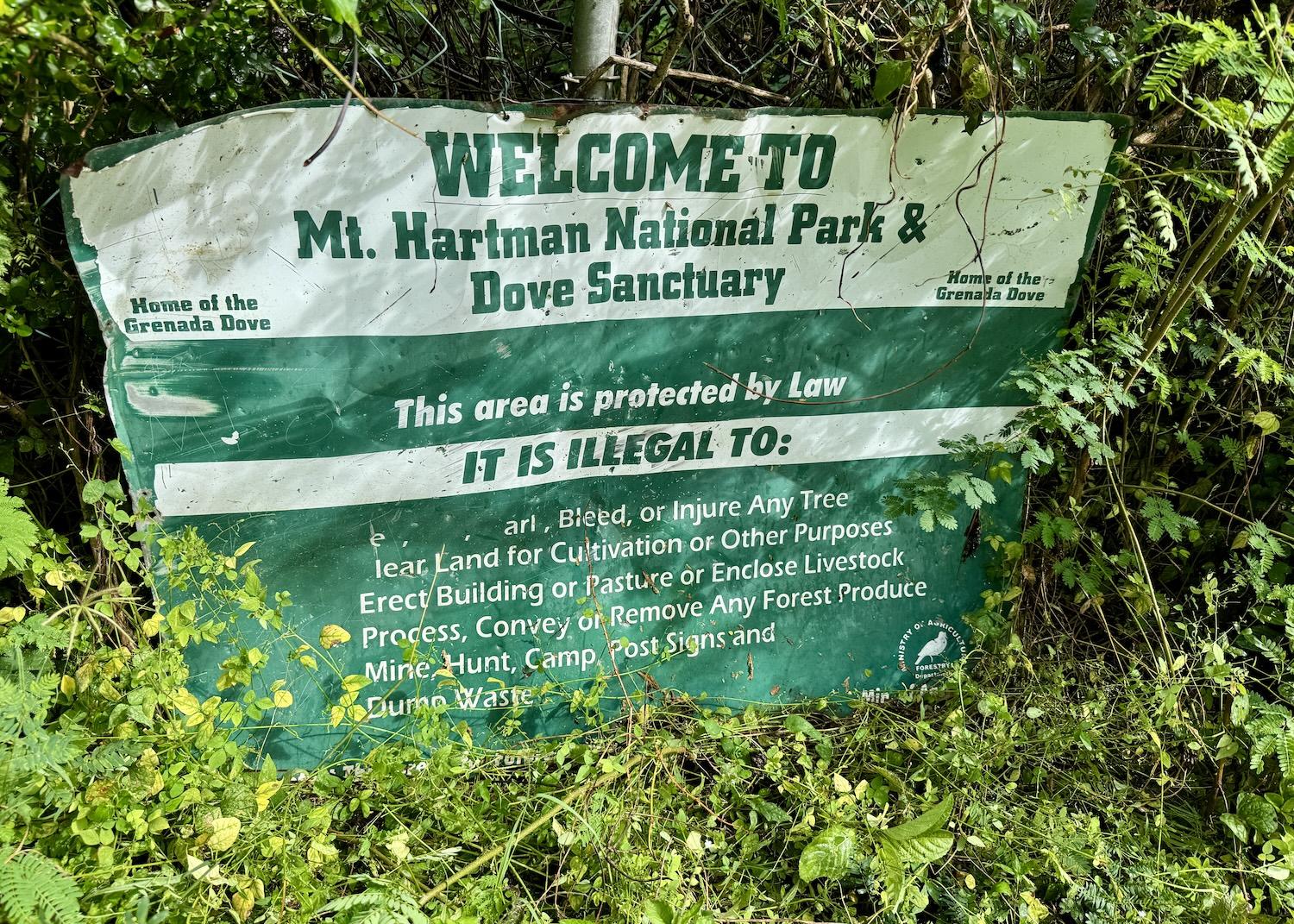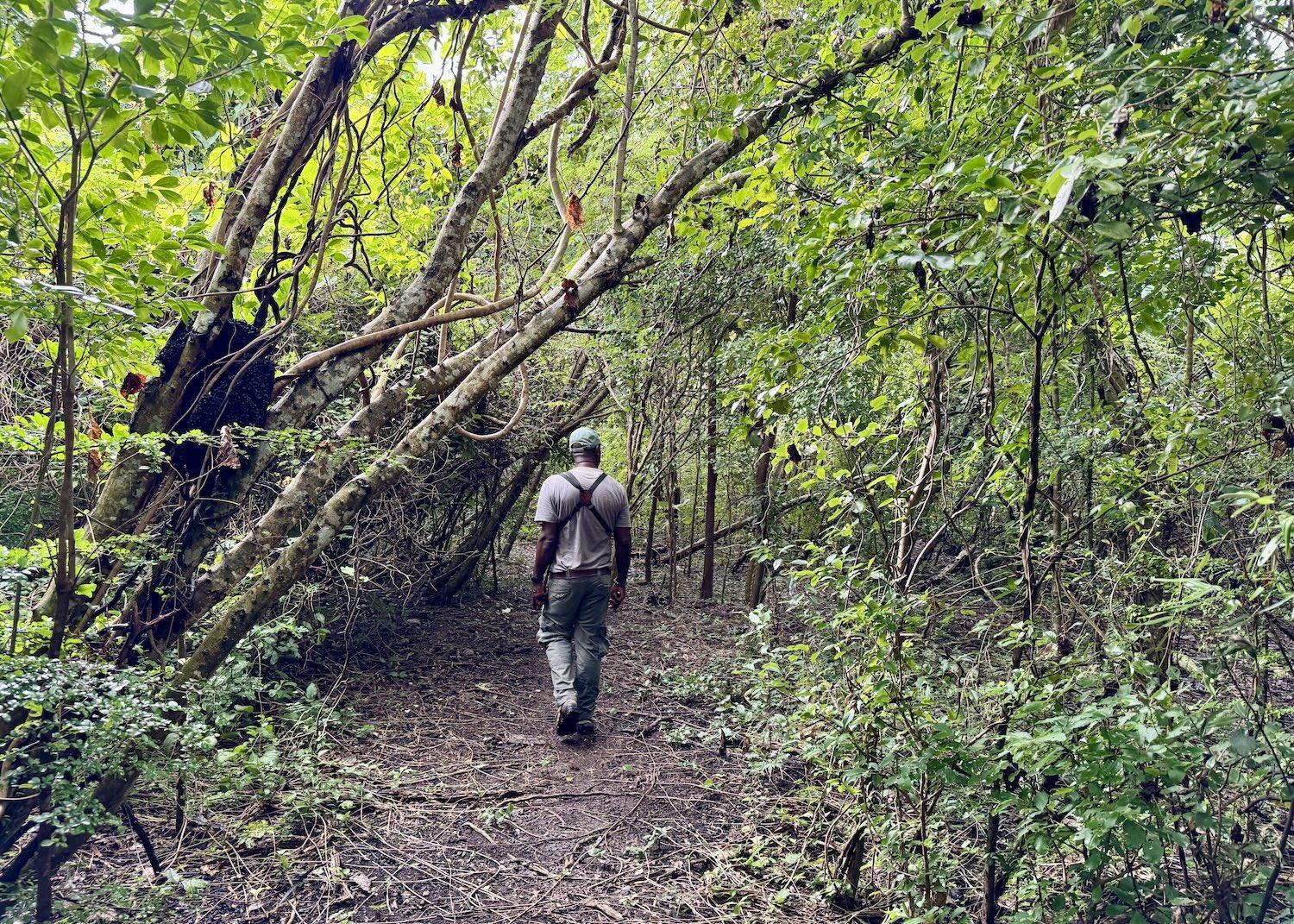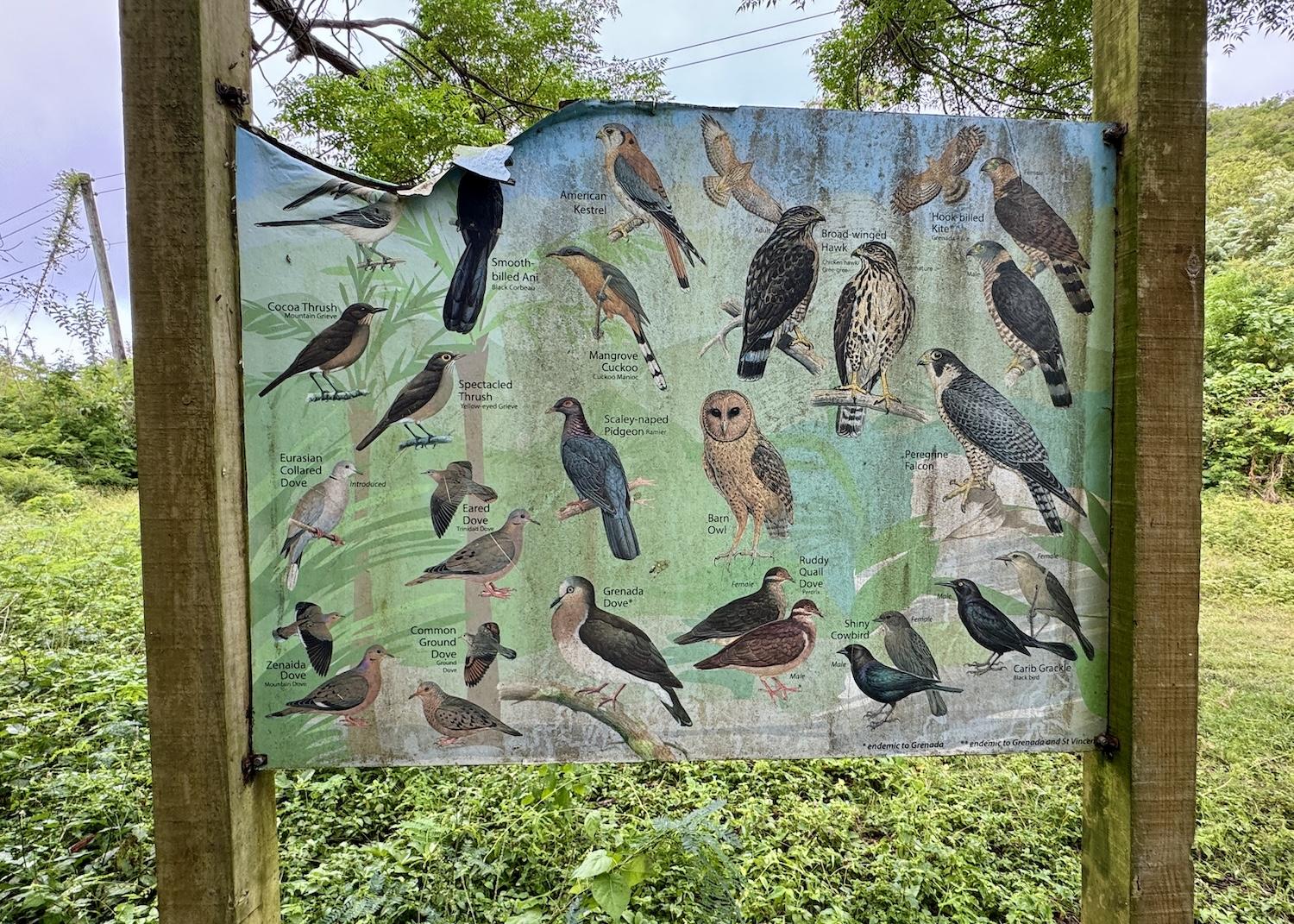Every seven seconds we hear it — the long, drawn out “hooooooo” of one of the world’s rarest birds. The Grenada Dove may be shy, elusive and critically endangered, but it’s cooing its heart out on this drizzly day in the Caribbean.
One. Two. Three. That’s how many doves Jerry Jeremiah is hearing. He’s a part-time bird guide and the full-time acting chief forestry officer with the Forestry and National Parks Department. There are fewer than 200 Grenada Doves left, all of them live on this island and many of them are right here in Mt. Hartman National Park & Dove Sanctuary.
“So the doves are in this general area, but to have a sighting, you will have to be very sensitive,” Jeremiah whispers. “First of all, you will have to be very quiet. The dove could either be perched in a tree, calling, or you can see them on the ground and then they will walk very fast away from you.”
We start creeping, quietly but hopefully, down the winding forest path.

The visitor center at Mt. Hartman National Park & Dove Sanctuary in Grenada isn't currently staffed or open, but is near a trail that goes through Grenada Dove habitat/Jennifer Bain
It was just by happenstance that I found this place while studying a tourist map. It was the first I’d heard of the dove sanctuary, just minutes from my resort, that protects a national bird that’s on the IUCN Red List of Threatened Species.
But was there a visitor center with eager guides or had it shut down? Should I just go alone or find someone willing to spend part of Grenada's Independence Day showing the Traveler around?
A flurry of persistent queries led me to Jeremiah, who cares enough about this little-known dove to share it with me on a public holiday. He drives us to the park’s small visitor center, a shuttered building behind a tattered sign showcasing the country’s most popular birds.
“The main focus for when I’m here is for persons to have a view of the Grenada Dove,” Jeremiah explains. “All the other birds — you’re likely to find them anywhere else. But exclusively when you’re here, then we focus on the Grenada Dove.”

American birder Art Cimento got to see the Grenada Dove thanks to bird guide Vaughan Francis of Tropical Adventures/Jennifer Bain
Two grinning men are leaving the sanctuary as we arrive. Local bird guide Vaughan Francis of Tropical Adventures has just helped Art Cimento from Nevada find two “pretty jumpy” Grenada Doves. “Unfortunately, if you’re seeking information at the hotels about birds and bird guides, you’re going to be misled 95 per cent of the time,” Francis sniffs when I detail my struggle to get here.
Sadly, the visitor center is no longer functioning, but I get to slip inside and meet the sanctuary’s security guard Peter Plenty who nonchalantly says he sees Grenada Doves every day.
The tabletop 3D relief map showing visitors the hills and peninsula that make up the park has seen better days. But six impressive interpretive panels, with photos by wildlife photographer Greg Homel, still help bring the Grenada Dove (Leptotila wellsi) to life.

A Grenada Dove, photographed by Greg Homel, is on interpretive signs inside the (closed) Mt. Hartman National Park & Dove Sanctuary visitor center/Jennifer Bain
This 12-inch-long, barrel-chested dove is brown with a white belly, a light pinkish brown upper chest and neck, and a greyish forehead that extends up from the bill. The legs, feet and bare skin around the eyes are red. Adults show white bellies, no markings on wings, outer tail feathers tipped with white, and a strip of white feathers that extends from its side up around the bend of the wing.
Threats include weather (particularly hurricanes) and climate change. Mongoose, rats, opossums and feral cats prey on nests and birds on the ground. The dove makes itself vulnerable to predators by spending most of its time scouring the ground for seeds. When flushed from a perch, it flies to the ground and walks away. Nestlings are just two weeks old when they move to the ground from trees.
Habitat loss is, of course, the biggest threat on this island near Venezuela that relies on tourism and is just 21 miles long and 12 miles wide. Dry forests like this that were once cleared for small plantations and charcoal production are now razed for residential and commercial development.

A Grenada Dove is painted on the wall inside the (closed) visitor center at Mt. Hartman National Park & Dove Sanctuary in Grenada/Jennifer Bain
For a spell, there was a groundswell of dove love. It became the national bird in 1991, replacing the Scaly-naped Pigeon (Ramier). Five years later, 154 acres of the government-owned Mount Hartman Estate was set aside in three separate parcels as a national park and bird sanctuary. Two parcels have since been merged. Surrounding lands have long been earmarked for a luxury resort — much to the dismay of activists — but proposed developments always seem to falter.
The sanctuary is run by the Ministry of Agriculture, Lands, Forestry, Marine Resources & Cooperatives, but managed by the Forestry and National Parks Department. Bonnie Rusk, conservation biologist and the founding director of the Grenada Dove Conservation Programme, has been a driving force in championing this secretive species.

A sign welcoming people to Grenada's Mt. Hartman National Park & Dove Sanctuary lays out the rules/Jennifer Bain
Gone are the days, though, when generous grants built, and rebuilt, this visitor center, and funded school programs, pamphlets, bookmarks and even billboards to spread the word about this national treasure. There's not likely much money to be made on a tiny national park that protects such a sensitive species. (At busy Grand Etang National Park, with a volcanic crater lake and hiking trails, the entry fee is just $2 USD.)
“The Grenada Dove stays hidden deep within the forests and rarely, if ever, wanders out,” interpretive signs here at Mt. Hartman explain.
“You are more likely to hear a Grenada Dove call than to see one. Please respect its habitat, and stay on the trails in those areas set aside for visitors. If you are patient and remain very still and quiet, with a little luck, you may see one walking on the ground.”

Bird guide/forestry officer Jerry Jeremiah strolls through Grenada Dove habitat/Jennifer Bain
As I follow Jeremiah down the trail, he cautiously rounds each corner hoping there’s a dove ahead. We chat quietly about how Mt. Hartman is in a part of Grenada that receives the lowest amount of annual rainfall. This rare dry forest ecosystem is made up of thorny cactus shrub and coastal woodland, often referred to as picker bush.
Doves need fresh water to survive, which can be a challenge during the dry season in the first half of the year. When they breed in the rainy season, territorial males call from trees.
“The dove could be perched in a tree, calling, and that’s mainly during the time of the breeding season. You can sneak up on them very easily and quietly and have a sighting,” says Jeremiah. “But in the dry season, which is different and where the vegetation completely transforms into total defoliation of most of the habitat here, the dove can be seen walking on the ground. So in the dry season you get a better photo opportunity, and a better viewing opportunity of the doves on the ground.”
 Birding guide Jerry Jeremiah strolls by a viewing tower built at Mt. Hartman so national park/dove sanctuary visitors could have a welcoming place to listen for (and perhaps see) Grenada's national bird/Jennifer Bain
Birding guide Jerry Jeremiah strolls by a viewing tower built at Mt. Hartman so national park/dove sanctuary visitors could have a welcoming place to listen for (and perhaps see) Grenada's national bird/Jennifer Bain
It’s February, the start of the dry season, but it’s also raining so who knows how the doves feel.
Just a few minutes down the trail, we reach a 20-foot viewing tower that was built (when the grant money was flowing) so visitors wouldn’t have to walk too far for a chance to hear doves. This is around the spot where we start hearing loud cooing sounds in the distance.
“Getting a photo of the dove is very, very tricky,” warns Jeremiah. “As we go along, if I happen to see a dove, I’ll use my pointer and I will let you know. I try to tell people to try to see the dove with your naked eyes first. And then later on, if you can, have it seen through your binoculars. And then later on, if you have a photo opportunity, you can take it.”

Birder Jerry Jeremiah is acting chief forestry officer with Grenada's Forestry and National Parks Department/Jennifer Bain
The calling abruptly stops so we press on until coming to a clearing where Jeremiah usually sits on a rock and scours the horizon for Hook-billed Kites. But there’s that distinctive "hooooooo" again.
“Wow, we have a dove calling,” says Jeremiah. “Wow, strong calling. We should pounce on this one. Let’s hope he’s close to the trail.” As we re-enter the woods, the cooing stops. Normally Jeremiah would patiently stick around here for an hour or two, but we have limited time together so he keeps walking and does his best Grenada Dove imitation.
“Hooooooo.”

The critically endangered Grenada Dove that we spotted Feb. 7, 2025 in Mt. Hartman National Park & Dove Sanctuary/Jennifer Bain
The next moments are a blur but at 10:22 a.m. on Independence Day, a Grenada Dove flies above us and lands on an acacia tree about 15 feet away. We can’t tell if it’s male or female but it happily stands there, 15 feet above the ground, for about a minute.
I freeze, find the shadowy figure with my naked eye, skip the instructions to admire it through binoculars, and try to photograph it as it stands between branches. I was grateful when we simply heard doves. Now I’m ecstatic to see something so rare. Consider me smitten and eager to spread the word.
“It flushed to the ground and I think it walked away as they normally do,” Jeremiah later says with delight. “It’s good that you got your own photo. This is evidence.” Many Grenadians, he confides, don’t believe this bird exists. Or they mistake it for one of the island’s four other doves — the Zenaida Dove, Eared Dove, Common Ground Dove and Ruddy Quail-Dove — even though they look nothing alike.

A two-sided sign at Mt. Hartman National Park & Dove Sanctuary reveals the birds to expect in Grenada/Jennifer Bain
A downpour is coming. Stumbling down a muddy tangle of unmarked trails that are re-routed whenever trees fall, I realize how reckless it would have been to come here without a guide. A Grenada Wren (newly identified as endemic), Scaly-naped Pigeon and Tropical Mockingbird serenade us as we race back to the car.
There is just enough time for a quick spin outside the park’s boundary to see the start of a Chinese-backed development (perhaps a hotel/university), illegal dumping and a patch of forest where wood is openly burned to make charcoal for the lucrative barbecue market. It's sobering stuff but I can't help but think how much potential the park/sanctuary has, and how much difference nature-conscious neighbors could make.
This impromptu birding trip ends on an upbeat note. Before parting ways, Jeremiah presents me with a button that says “I Love My Dove” and features a winsome sketch of a Grenada Dove. “So you can boast about it,” he says. “You saw the dove — and you have your replica.”
Visiting Grenada's Oldest National Park:

Brought to Grenada on slave ships from West Africa, mona monkeys are still hunted on this Caribbean island but are protected in Grand Etang National Park/Jennifer Bain
Established in 1906 to safeguard 3,816 acres of tropical rainforest, Grand Etang National Park & Forest Reserve is the oldest and largest protected area in Grenada. Grand Etang Lake, in the crater of an extinct volcano, is the centrepiece. The mona monkeys that hang out near the visitor center were brought over from West Africa on slave ships, possibly as pets or a source of wild meat. There is still a hunting season for them in parts of Grenada.
Hiking is best done with a guide so I visit some unusual roadside trees instead. A huge Rainbow Eucalyptus dubbed the Rainbow Tree has smooth bark that peels away in strips to reveal shades of orange, green, gray and purplish brown. Some people have marred this "living painting" with graffiti, but the layers will eventually flake away so the tree may one day be unblemished again. Native to the rainforests of the Philippines, Indonesia and Papua New Guinea, the eucalyptus was planted here at the southwestern edge of the park in 1977 to help stabilize the bank.
The Rainbow Tree — a popular photo stop — is next to an overlooked ornamental plot where the Department of Forestry and National Parks grows Christmas trees. Last December, staff quietly harvested about 70 of these trees (they're cypress, not pine or fir), sold 50 to locals and donated the rest so Grenadians could have a Christmas tree experience.

The Rainbow Tree at the southwestern edge of Grant Etang National Park is marred by graffiti/Jennifer Bain



 Support Essential Coverage of Essential Places
Support Essential Coverage of Essential Places






